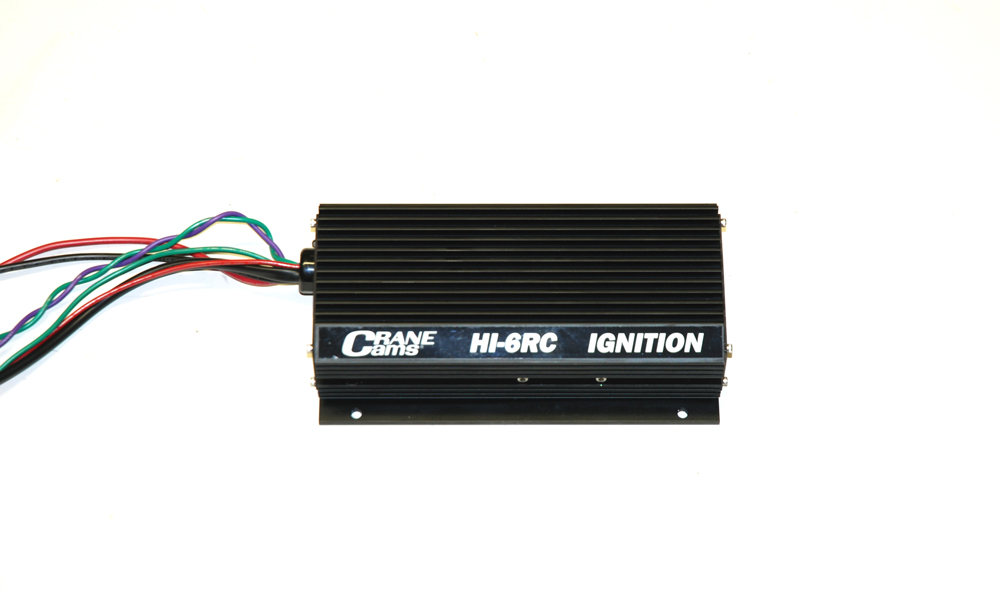

Photos: Crane Cams
In the first segment on reliable high power race ignition systems, we devoted all of our available space to distributors. If you recall, Crane manufactures a series of slick (and simple) locked advance, optically triggered distributors. It’s a well-proven configuration that is both accurate and robust.
So far so good, but when it comes to ignition boxes, Crane offers several systems that follow the very same pattern: Simplicity and toughness. Those are both great qualities, but one thing that really attracts us to these ignition boxes is the ease of use. On one end of the ignition box you’ll discover a set of simple, easy-to-set rotary switches. Different boxes have different functions but we’ll get to that in a bit.
Externally, most of Crane’s ignition control boxes look similar. They’re housed inside a deeply finned aluminum shell that also serves as a heat sink: heat created by the electronic circuitry is dissipated by way of the fins. The majority of the control boxes are sealed and potted. When turned upside down, you can see how the electronics are sealed in a urethane potting material. The stuff looks and feels like gelatin, but the idea is to keep the electronic parts dry, free of foreign material and at the same time guard against damage from vibration.
Both of the Crane ignition boxes we’re focusing in on incorporate “digital” technology. As you know, we’re living in a digital world. The same applies to ignition systems – you can get ignition boxes in analog format or digital format. Is a digital system superior to an older analog system? Certainly, but before we dig any deeper, think about the differences between the computer you’re viewing this on and an old-fashioned adding machine (you know – the one with the crank on one end!).
The computer is capable of storing a program (this allows it to repeat operations and make “logical” decisions) and simultaneously store and retrieve data without any assistance on your part. That old adding machine was done every time the crank was pulled. Its like the old clock on the wall with the big sweeping hands. In comparison is the clock on the face of your microwave oven. It’s most likely some sort of digital device. The old-fashioned sweep hand clock is actually trying to recreate the information as it actually happens. Meanwhile, the digital clock in the microwave is really presenting the same information but it’s in what’s called a “discrete demonstration.” In other words, it displays one piece of information at a time. The microwave clock takes the information and presents it to you as a series of changes, or “bits,” that are represented in code by zeros and ones.
An analog device such as the sweep hand clock represents data as physical quantities and works on the data by manipulating the quantities. That digital device (microwave clock) works with data expressed in binary notation. What this is is a series of on-off conditions that represent the digits 1 and 0. Eight consecutive binary digits, or bits, is called a byte and allows for 256 on-off combinations. That means each byte can represent one of up to 256 alphanumeric characters. Math along with other comparative operations can be performed on the data and the result of that math can be stored for later use.
Whew. Okey-Dokey. It makes our head spin. But the reality is, there is a direct correlation from geek-speak to today’s ignition systems: A digital-based ignition system will make its firing “decisions” based upon data. If it receives a “command” to perform a function, it can perform the task instantly. Better still, it has the capability to repeat this process time and time again. Basically, digital systems are infinitely repeatable (unlike that old sweep hand clock that quite often needed adjustment every day or two).
So far so good, but what the difference between a couple of common (and seemingly closely related) Crane ignition boxes? We asked the same questions. Two of the most common ignition boxes from Crane include the HI-6RC and the HI-6DSR. Either of the two is perfect for street and/or strip applications. Next issue we’ll dig deeper in the pair of ignition boxes.







Leave a Reply